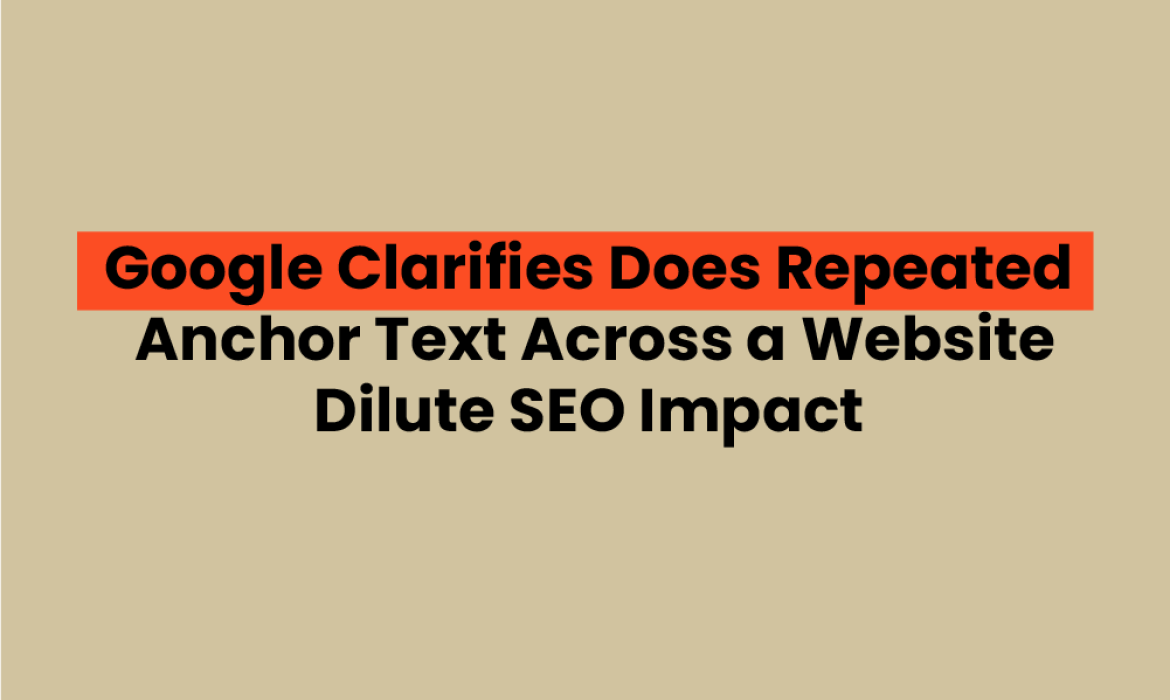In the ever-evolving world of SEO, even the smallest details can spark concern among marketers and webmasters. One such worry that resurfaced recently is whether repeatedly using the same anchor text across a website could dilute its SEO value. Google’s John Mueller has stepped in to provide clarity, addressing concerns about internal site navigation and repeated links.
Let’s break down what was asked, Google’s response, and what this means for your SEO strategy moving forward.
The Question at Hand: Too Many Identical Links?
An SEO professional posed an interesting question: they had a client website with four distinct navigation areas – a main menu, footer links, sidebar quicklinks, and a related pages mini-navigation in posts. Across all four sections, they were linking to the same page using identical anchor text.
The worry? That this repeated anchor text across hundreds or thousands of pages might dilute the page’s ability to rank for the targeted keyword.
This concern stems from long-standing SEO myths and misunderstandings about how Google interprets internal links and anchor text.
Why Are SEOs Worried About Anchor Text Overuse?
To understand this concern, we need to look back at SEO history.
In the early 2000s, Google revealed that it was using statistical methods to detect unnatural linking patterns, both internal and external. This sparked fears that overusing the same anchor text could be seen as manipulative or spammy, potentially harming rankings.
Later, Google further clarified its handling of sitewide links (links repeated across every page). It introduced damping mechanisms to ensure that these links didn’t pass inflated value just because they appeared thousands of times. For example, buying a footer sitewide link on a major site no longer carried the massive ranking power it once did. Instead, Google essentially counts such links as a single signal.
These clarifications shifted the SEO conversation from “overuse equals penalty” to “overuse may reduce the unique weight of each link.”
But does that mean identical sitewide anchor text actually dilutes keyword ranking power? Let’s see what John Mueller says.
John Mueller: No Need to Worry
John Mueller responded directly to the SEO’s question on X (formerly Twitter), saying:
“Having 4 identical links on a page to another page seems fine & common to me, I wouldn’t worry about that.”
He clarified that the concern over anchor text dilution stemmed from a misunderstanding. The situation being worried about here is different from an outdated SEO tactic called flat site architecture – where every page links to every other page to artificially spread PageRank.
In the case presented, the repeated links came from navigational elements, not intentional manipulative link structures.
Google understands that websites naturally have repeated links in footers, sidebars, and menus. These are not treated the same way as in-content, contextual links. Instead, Google segments pages into components: header, navigation, sidebars, main content, and footers. The real weight comes from contextual, in-content links because they carry meaning and editorial relevance.
Semantics and Structure: Does It Matter?
The SEO further explained their concern, saying the sidebar and related page links weren’t technically labeled as “navigation” but were just HTML list structures. They feared this introduced too much duplication.
John Mueller’s position still holds: Google isn’t fixated on whether a section is semantically tagged as a nav or a div; it’s focused on what part of the page the content appears in.
Martin Splitt, another Google expert, elaborated on this in past talks by explaining how Google isolates the “centerpiece” content from additional surrounding elements like related links, boilerplate, or repeated sections. Google has sophisticated systems to separate primary content from supplementary site elements, ensuring that only meaningful links factor significantly into ranking signals.
In short, Google knows what’s what on your site.
How Google Treats Sitewide Links Today
Google has been dampening the effect of both external and internal sitewide links since around 2006. Sitewide links, even when repeated thousands of times, essentially count once for ranking purposes.
Here’s why:
- Context matters. Navigational links are seen as signals of importance within a site structure, not as votes of endorsement like editorial links.
- Quantity doesn’t multiply value. Google ignores inflated counts and focuses on unique linking relationships.
- Page segmentation helps Google focus. Only the main content and in-content links hold meaningful ranking weight.
So, unless you’re using manipulative practices (like cross-site double serving or doorway pages), repeated internal anchor text across navigation areas won’t hurt you.
What Should You Do as an SEO or Website Owner?
While it’s good to be cautious, this situation shouldn’t cause alarm. Here’s how you can stay on track:
- Focus on user experience. Ensure that your navigation helps users, not just search engines. Logical, clear menus and related links enhance usability.
- Avoid artificial manipulation. Don’t stuff pages with hidden links or artificially inflate anchor text just to target a keyword.
- Invest in contextual linking. When you want to pass meaningful signals, place links within your main content, surrounded by relevant text.
- Regularly audit your site structure. Check that your menus, sidebars, and footers aren’t cluttered or redundant. Streamlined navigation benefits both users and crawlers.
- Stay informed. Follow Google updates and best practices so you can separate myths from real SEO risks.
Final Takeaway: Stop Worrying About Dilution
Google has repeatedly emphasized that it understands how websites work. Having repeated anchor text in navigational links across your site won’t dilute your ability to rank for that keyword. These links act as structural signals, not editorial endorsements.
Instead of obsessing over whether four identical links are too many, focus your SEO energy where it truly matters: crafting great content, building relevant contextual links, improving user experience, and maintaining technical site health.
By aligning your SEO practices with how Google actually reads your site, you set yourself up for sustainable, long-term success.



